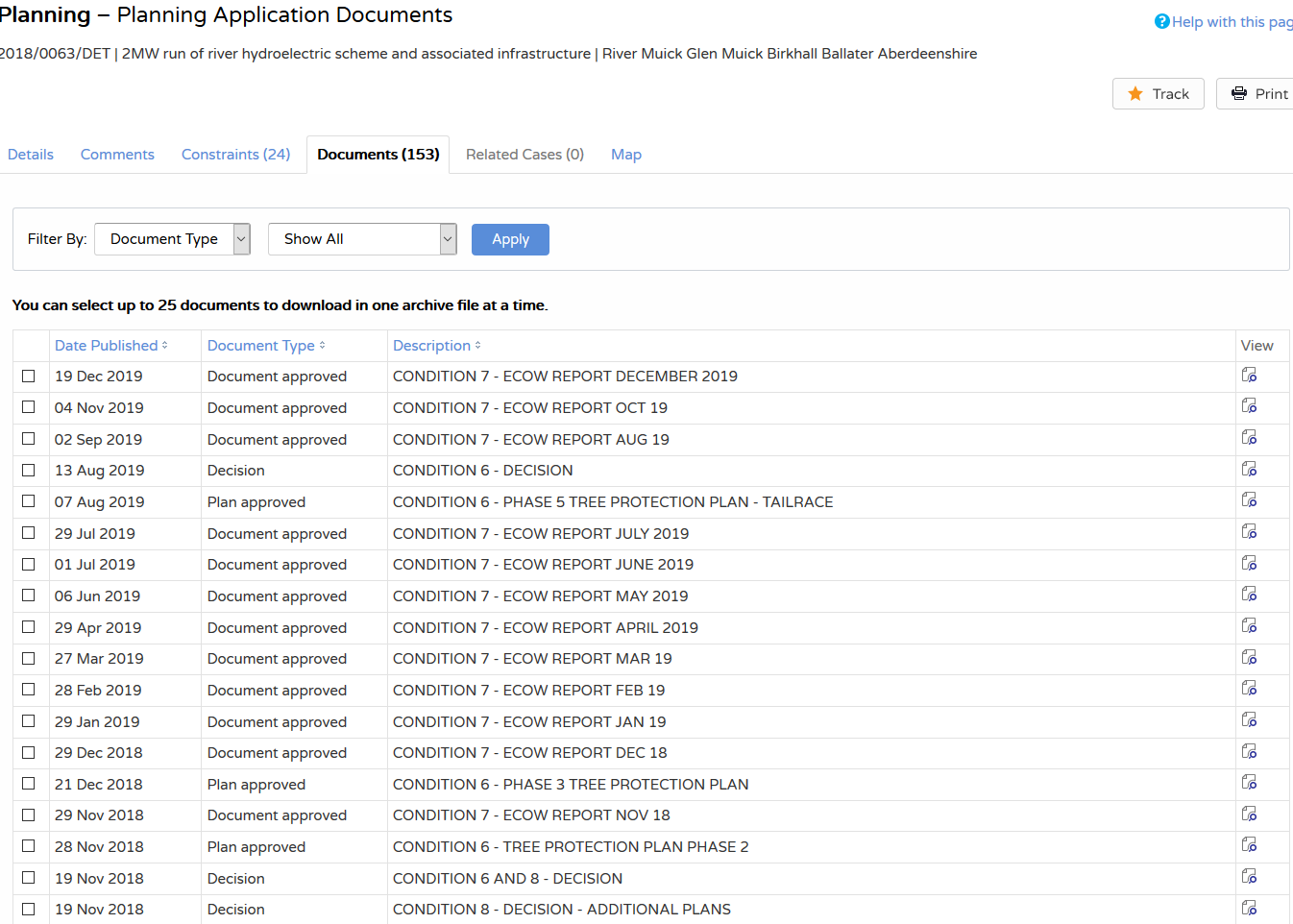
When I first came across the destruction caused by the Bruar hydro scheme (see here) in August 2016 I tried to find out what had gone wrong by looking at the documents associated with the planning application on the Cairngorms National Park Planning Portal. There was not a single document on the planning portal after the “Decision Notice” which gave the go ahead to the development. What that meant was it was impossible to tell whether the destruction was officially endorsed – i.e according to plans! – or whether Atholl Estates had breached the terms of the planning conditions and the Cairngorms National Park Authority was taking action about this.
I therefore emailed the CNPA Director of Planning and Rural Development, Murray Ferguson, some photos. In the course of the subsequent correspondence, in which the CNPA readily accepted there were some serious issues, I was provided with some documents but as importantly CNPA staff said they would look into such documents being routinely published on the planning portal in future. I had been waiting three years since but, soon after sending a rather frustrated reminder to the Head of Planning last week, discovered that the CNPA has been publishing post-planning documentation for the last year for a hydro development – at Balmoral of all places!
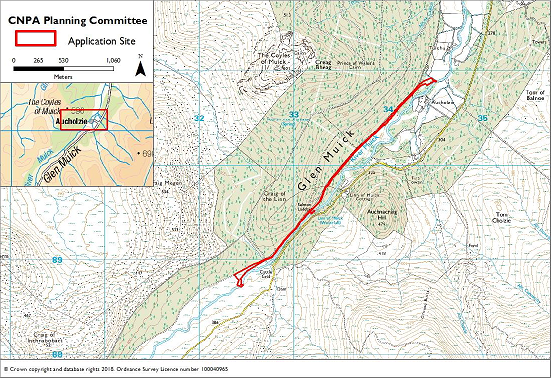
The Glen Muick hydro planning documentation
The CNPA has published on its planning portal no less than 78 documents (screenshot above) for the Glen Muick hydro (see here) since it issued its Decision Notice in July 2018. They appear comprehensive, including not just the various detailed plans required by the Decision Notice but also the monitoring reports required by the Environmental Clerk of Works (ECOW). This is a major step forward for transparency and the CNPA are to be congratulated.
What this means is that ANYONE who is concerned about the development can see the detail of what has been agreed and what the issues might be at any one time just like the planning officer. Up until now even if you lived by a development and could witness work on a daily basis you would still have no idea about whether this was in accordance with agreed plans or not as these were withheld from publication. Moreover, if you don’t live by the site, instead of having to go and look yourself – which is difficult in remote rural areas – you can get a reasonable idea of what is going on through the ECOW reports.
For example, the charity Buglife originally objected to this hydro scheme because of its potential impact on aquatic invertebrates in the River Muick but then asked for monitoring during the construction period and afterwards. They can now access all the relevant documentation and, if they have any concerns, can submit informed comments or complaints. That’s empowering for all the organisations who are working to protect the natural environment and landscape in Scotland.
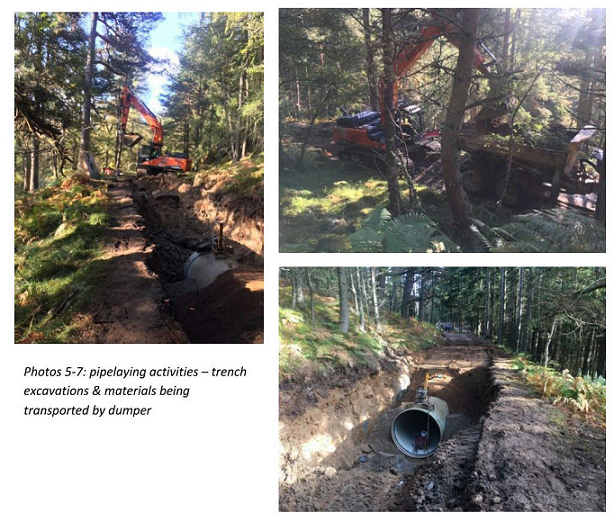
Many of the photos in the ECOW reports provide assurance that this scheme is being carefully constructed. Note the narrow width of the pipeline trench above and how its being backfilled almost immediately, which reduces erosion risks. The photos raise important questions about why such good practice has not been applied to the construction of ALL hydro schemes? If the Glen Muick pipeline, which at two megawatts is massive for a run of river hydro scheme, can be constructed along such a narrow corridor, why did the construction corridors in Glen Bruar (link above) or the many schemes in the Loch Lomond and Trossachs National Park have to be so much wider?
The publication of the ECOW’s reports may also help them become more critically objective. Since the ECOW’s are engaged and paid by the developer, the risk is that if they are too critical of what is going on, they won’t get paid or could have their contract terminated. If they know their reports will be made public, however, suddenly their professional reputation in the wider world as well as their pay is at stake.
Its good to see from these ECOW reports that issues have been raised in the course of their visits and also addressed:
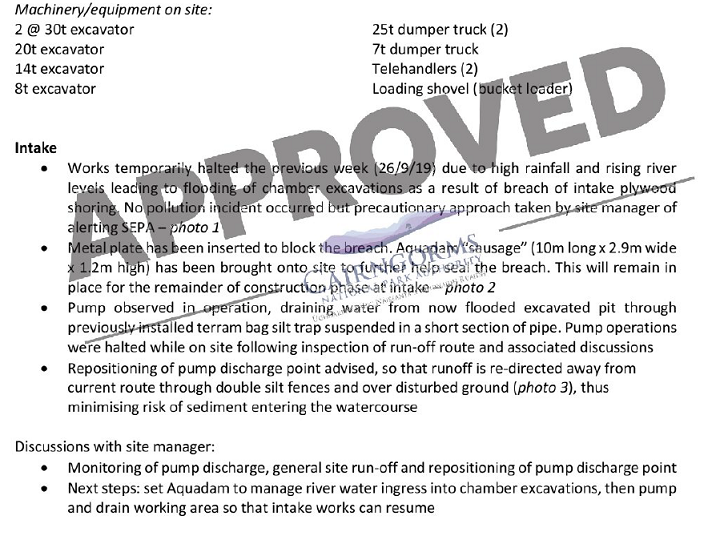
This doesn’t mean everything is perfect BUT if you had a close interest in a development and were not satisfied with how an ECOW had dealt with an issue publication of their reports makes it much easier to take an issue up with the Park Authority.
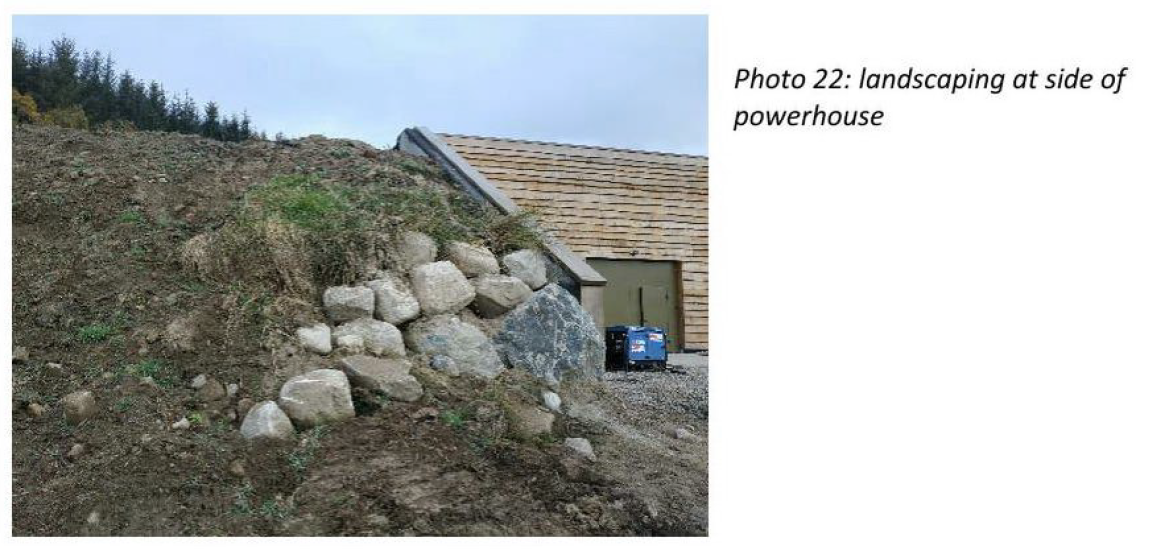
For example, this piece of “landscaping” looks pretty dire! Its easy enough to cut and paste the photo, send it to the Planning Officer and, because no remedial action is given in the ECOW report, ask the planning officer to take this up.
This increased transparency enables stakeholders to hold developers to account in a way that has been very difficult up till now – hence I believe many of the planning disasters where developers have simply ignored planning conditions. There are, however, a couple of aspects of this development where transparency could have been improved further.
The first is that if you had been interested in monitoring this development, it would not be that easy to tell when the work actually started. I don’t see why notices to Planning Authorities giving the start date for work should not be published in all cases.
The second relates to the associated development, the installation of a new 5km cable between the powerhouse and the grid, which was subject to a separate planning application (see here):

Looking at the power cable application on the planning portal, it demonstrates the normal practice among Planning Authorities and the CNPA. Not a single document has been published post the Decision Notice and you cannot tell from the application if the work has started or not. Its clear, however, from the ECOW reports that they have ALSO been monitoring this application and its well underway:
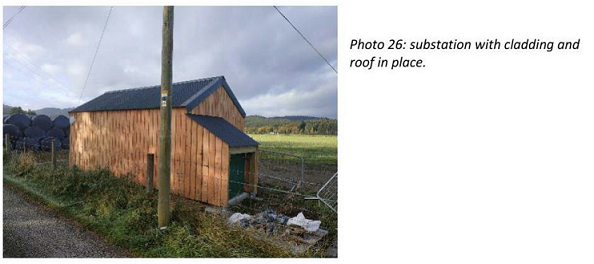
So why couldn’t the CNPA at least have linked the Cable Application to the Hydro Application, noted the start date for the works (if different from that of the hydro scheme) and refer the public to the Hydro Application if they wanted access to further information?
As long as the CNPA, however, is committed in principle to making information about the implementation of Planning Decisions public, there will be plenty of opportunities to improve how they do this over time. The key thing is that what has happened with the Glen Muick hydro sets a precedent and new standard for best practice across Scotland. For once, a Planning Award might be justified.
Planning Transparency in Highland & the Loch Lomond and Trossachs National Park
As a result of efforts by the Save Glen Etive campaign, Highland Council have committed to publish documentation relating to the 7 hydro schemes they have approved there.
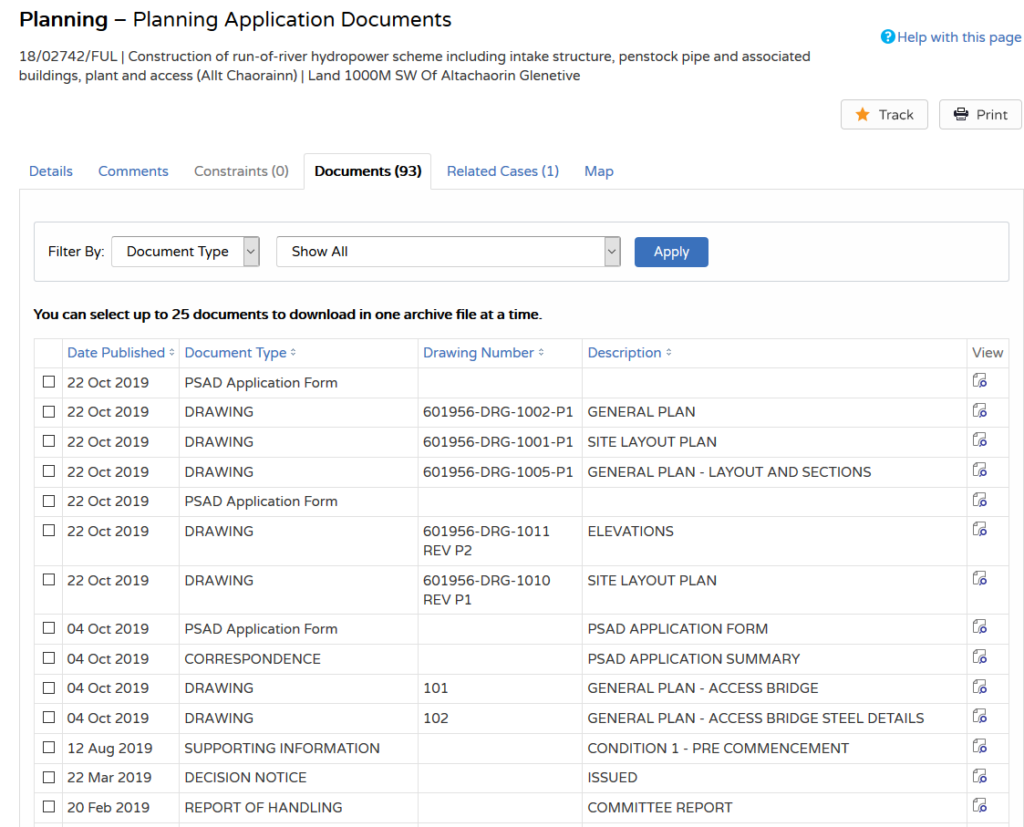
While 10 months on relatively little has been published for the Glen Etive schemes, part of the reason for this appears to relate to the ability of the developer to submit the required documents (about which more soon).
The contrast between Highland Council and the CNPA and the Loch Lomond and Trossachs National Park Authority is quite stark. I have been asking the LLTNPA now to publish information received post the Decision Notice for three years now without any successt. The attitude of the LLTNPA is that if the public wants access to this information they should ask for it under Freedom of Information laws and they will then spin out the process for the maximum time possible (see here for the Ledcharrie Hydro Scheme saga).
My latest request to the LLTNPA to address these issues was handed over to Stuart Mearns, the Director of Planning and Rural Development, months ago and I have heard nothing since.
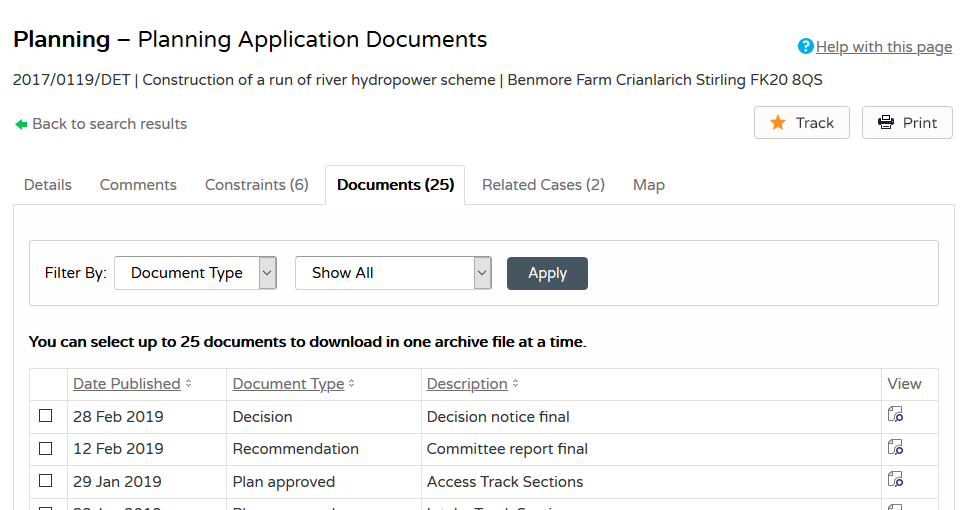
The Ben More Hydro scheme (see here) which the LLTNPA approved last year, just before the final deadline for new hydros to qualify for lucrative subsidies from the public, provides a perfect example of the issues. Nothing has been added to the Planning Portal since the Decision Notice – you can be certain the Park holds dozens of documents.
I had been wanting to monitor this scheme but, in the absence of a friendly contact in Crianlarich, it was impossible to tell when work commenced. How convenient for senior management in the LLTNPA!
Work commenced sometime in the summer/Autumn and, when I went past a week ago in the pouring rain, appeared near completion. Its impossible to tell whether the work has been carried out in accordance with the detailed plans agreed by the LLTNPA or not. because these are being kept secret. The new road high up across the hillside appears to have formed another landscape scar in Glen Dochart as several objectors predicted.
The LLTNPA uses this absence of information to make it much harder for the public to raise concerns or complaints about the way a development is being constructed. Their inevitable reply is their judgement is the work is “broadly” in accordance with what has been agreed. There is no chance of contesting this unless you have a copy of what was agreed in front of you.
The LLTNPA then makes it as difficult as humanly possible to get hold of this information by forcing people to submit time-consuming information requests which is then reported to the Board as “unnecessary” work that has been created by members of the pesky public!
Thereason for this, as I argued in my post on the bonnie banks last week (see here), is that the primary purpose of the LLTNPA as Planning Authority is now to serve developers, rather than the public interest. Ever since I revealed through FOI requests that the Park’s then Convener of Planning, Owen McKee, had been trading in Cononish goldmine shares, the stench of corruption has hung over the National Park Authority. The LLTNPA did their best to cover that up and have NEVER acted to address the issues. Until there is Planning transparency and all important decisions are considered as a matter of course by Board Members, nothing will change.
Final word – what needs to happen!
While the CNPA may not have published Post Decision planning information up until now, I have always found their staff more than helpful in providing documents they have held without any need to go through formal Information processes. So, while they were no better than the LLTNPA in the way they published routine information, their attitude to providing this when requested was totally different.
That’s been a major reason why I have held back from criticising them as much of the LLTNPA. The CNPA is a much better Planning Authority and changing systems – though I suspect most of the information which is on a single data base can be published at the touch of a button – and changing work practices can take time. That is particularly the case when our Planning Authorities are being crushed by austerity.
Now the CNPA have initiated this good practice, however, its important its rolled out and that other Planning Authorities follow their example. This could have benefits for the whole of Scotland.
There is a risk that the CNPA is now quietly pressurised by development interests, both inside and outside government, to abandon this good practice. I would therefore urge anyone who supports greater planning transparency to use any opportunity you have to support what’s happened and argue for other planning authorities to follow the CNPA’s lead. Perhaps, with the Royal Family in the vanguard for a change, greater planning transparency will suddenly become a fashionable cause among other large landowners?
I still cannot believe that crooked b*****d McKee has not been disciplined for the blatant abuse of his position.
Corruption runs deep.
McKee did resign from the Board once his share trading was made public (the Board had done nothing, did not even report him to Commissioner for Ethical Standards in Public Life) but then stood again for the Board in the National Park elections for local members last year.
Over the years, I have seen the CNPA planning service and the operation of the planning committee steadily improve. Both the Director of Planning and the Committee Convenor have worked hard to improve the processes involved and have always recognised and respected the right of challenge of both committee members and the public. It is good to see post decision information posted on the planning portal – I’m quite sure that there is a lot more extra work in keeping up with this than might imagined, especially in a small planning team with much more than just the applications themselves to keep pace with – so I hope this is something that can and will continue and broaden out to every approved application in the future, with every Scottish planning authority. Should that happen, however, I fear that LLTNPA may be the last bastion of obstruction.